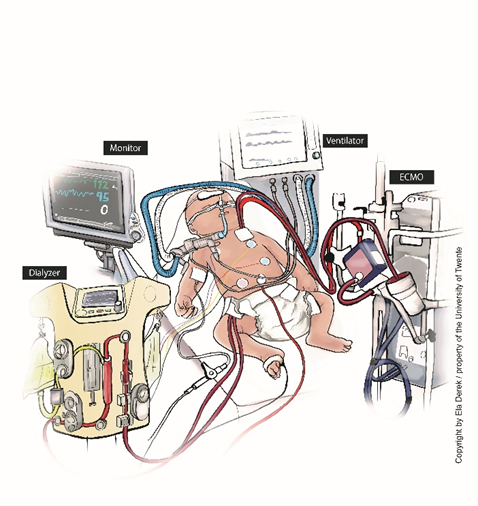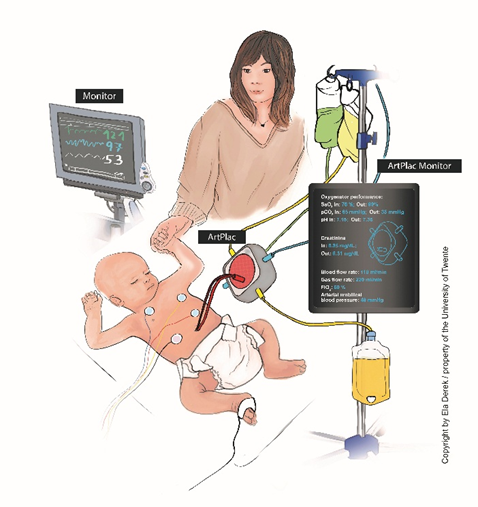Yearly, around two million neonatal deaths occur worldwide. In many cases, the deaths occur due to fatal lung failure sometimes combined with kidney failure. Together with partners from academia and industry from the Netherlands, Germany, Sweden, Ireland and Canada, TechMed researchers Jutta Arens and Dimitrios Stamatialis aim to develop a novel artificial placenta system, the ArtPlac. To do so, they have been awarded an EIC Pathfinder grant.
The placenta is a fetal organ that provides the unborn baby with nutrients and oxygen and removes waste products while it’s in the womb. Outside the womb, the placental function should be taken over by the baby’s own organs. However, in many of the two million neonatal deaths that occur worldwide yearly, this takeover goes wrong, manifesting in fatal lung failure sometimes combined with kidney failure.
Current method is invasive
In the current intensive care, newborns face highly invasive and high-risk interventions. They are attached to, for example, mechanical ventilation and other medical devices initially developed for adults and downscaled for neonatal care which require several surgically placed lines (Fig. 1A). This makes the intensive care treatment for newborns very stressful, and it can lead to lifelong disabilities.
All-in-one device
The ArtPlac device will be low-invasive and can be attached to the umbilical cord. “The ArtPlac is a game changer,” says TechMed researcher Jutta Arens, “Current research often tries to just downscale existing medical devices for adults, but newborns are not just small adults, but have very sensitive bodies. Therefore, we will use the natural placenta as a blueprint. Our novel device simply connects to the belly button for lung and kidney support while the baby can breathe, mature, and heal.” This all-in-one device will not only combine lung and kidney support in one device but will also provide the necessary inline monitoring and control, see Fig. 1B.
|
|
Fig. 1A: Invasive state-of-the-art setup with respirator, four surgically placed lines, attached extracorporeal lung assist and dialyzer with paralyzed newborn. | Fig. 1B: ArtPlac – one device attached to the umbilical cord combining lung and kidney support, inline monitoring, and control. |
Unique technologies
To develop the ArtPlac, the researchers will work on and apply tailored design approaches and new technologies such as new membranes, microfabrication, microfluidic systems, and sensor technology. All to make the device as small and noninvasive as possible. “Several elements of the developed technology could also be used for portable artificial kidneys and lungs for pediatric and adult patients,” says TechMed researcher Dimitrios Stamatialis.
More information
The ArtPlac consortium was granted around four million Euros from the EIC Pathfinder programme among which one million Euros was granted to UT researchers, Prof. Dr. Jutta Arens (Engineering Organ Support Technologies, Department of Biomechanical Engineering, Faculty of Engineering Technology) and Prof. Dr. Dimitrios Stamatialis (Advanced Organ Bioengineering and Therapeutics, Faculty of Science and Technology)
The Pathfinder programme is one of the funding instruments of the European Innovation Council (EIC) to support the exploration of bold ideas for radically new technologies. It welcomes the high-risk/high-gain and interdisciplinary cutting-edge science collaborations that underpin technological breakthroughs.
The Artplac project is part of the TechMed strategic impulse programme KETs4PM on ‘Personalised Renal Health’ which aims to provide a technological drive to transform health care and well-being.







